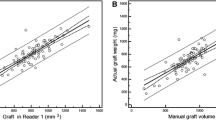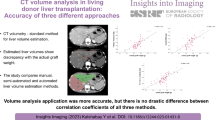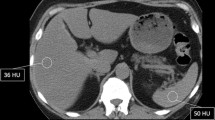Abstract
The aim of this study was to evaluate a software tool for non-invasive preoperative volumetric assessment of potential donors in living donated liver transplantation (LDLT). Biphasic helical CT was performed in 56 potential donors. Data sets were post-processed using a non-commercial software tool for segmentation, volumetric analysis and visualisation of liver segments. Semi-automatic definition of liver margins allowed the segmentation of parenchyma. Hepatic vessels were delineated using a region-growing algorithm with automatically determined thresholds. Volumes and shapes of liver segments were calculated automatically based on individual portal-venous branches. Results were visualised three-dimensionally and statistically compared with conventional volumetry and the intraoperative findings in 27 transplanted cases. Image processing was easy to perform within 23 min. Of the 56 potential donors, 27 were excluded from LDLT because of inappropriate liver parenchyma or vascular architecture. Two recipients were not transplanted due to poor clinical conditions. In the 27 transplanted cases, preoperatively visualised vessels were confirmed, and only one undetected accessory hepatic vein was revealed. Calculated graft volumes were 1110±180 ml for right lobes, 820 ml for the left lobe and 270±30 ml for segments II+III. The calculated volumes and intraoperatively measured graft volumes correlated significantly. No significant differences between the presented automatic volumetry and the conventional volumetry were observed. A novel image processing technique was evaluated which allows a semi-automatic volume calculation and 3D visualisation of the different liver segments.





Similar content being viewed by others
References
Emond JC, Renz JF, Ferrell LD, Rosenthal P, Lim RC, Roberts JP, Lake JR, Ascher NL (1996) Functional analysis of grafts from living donors: implications for the treatment of older recipients. Ann Surg 224:544–554
Ishifuro M, Horiguchi J, Nakashige A, Tamura A, Marukawa K, Fukuda H, Ono C, Akiyama Y, Kushima T, Ito K (2002) Use of multidetector-row CT with volume renderings in right lobe living liver transplantation. Eur Radiol 12:2477–2483
Kamel IR, Kruskal JB, Warmbrand G, Goldberg SN, Pomfret EA, Raptopoulos V (2001) Accuracy of volumetric measurements after virtual right hepatectomy in potential donors undergoing living adult liver transplantation. AJR 176:483–487
Schroeder T, Nadalin S, Stattaus J, Debatin JF, Malagó M, Ruehm SG (2002) Potential living liver donors: evaluation with an all-in-one protocol with multidetector-row CT. Radiology 224:586–591
Lamade W, Glombitza G, Fischer L, Chiu P, Cardenas CE, Thorn M, Meinzer HP, Grenacher L, Bauer H, Lehnert T, Herfarth C (2000) The impact of 3-dimensional reconstructions on operation planning in liver surgery. Arch Surg 135:1256–1261
Selle D, Spindler W, Schenk A (2000) Computerized models minimize surgical risk. Diagn Imaging Europe 12:16–20
Schenk A, Prause G, Peitgen HO (2001) Local cost computation for efficient segmentation of 3D objects with Live Wire. Medical imaging: image processing. Proc SPIE 4322:1357–1364
Schenk A, Prause G, Peitgen HO (2000) Efficient semiautomatic segmentation of 3D objects in medical images. Medical image computing and computer-assisted intervention (MICCAI 2000). Springer, Berlin Heidelberg New York, pp 186–195
Selle D, Peitgen HO (2001) Analysis of the morphology and structure of vessel systems using skeletonization. SPIE Med Imaging 4321:271–281
Selle D, Preim B, Schenk A, Peitgen HO (2002) Analysis of vasculature for liver surgical planning. IEEE Trans Med Imaging 21:1–15
Alpern MB, Lawson TL, Foley WD, Perlman SJ, Reif LJ, Arevalos E, Rimm AA (1986) Focal hepatic masses and fatty infiltration detected by enhanced dynamic CT. Radiology 158:45–49
Heymsfield SB, Fulenwider T, Nordlinger B, Barlow R, Sones P, Kutner M (1979) Measurement of liver, kidney and spleen volume and mass by computed axial tomography. Ann Intern Med 90:185–187
Van Thiel DH, Hagler NG, Schade RR, Skolnick ML, Heyl AP, Rosenblum E, Gavaler JS, Penkrot RJ (1985) In vivo hepatic volume determination using sonography and computed tomography: validation and comparison of the two techniques. Gastroenterology 88:1812–1817
Bland JM, Altman DG (1986) Statistical methods for assessing agreement between two methods of clinical measurement. Lancet 8476:307–310
Fan ST, Lo CM, Liu CL, Yong BH, Chan JK, Ng IO (2000) Safety of donors in live-donor liver transplantation using right lobe grafts. Arch Surg 135:336–340
Kiuchi T, Kasahara M, Uryuhara K, Inomata Y, Uemoto S, Asonuma K, Egawa H, Fujita S, Hayashi M, Tanaka K (1999) Impact of graft-size mismatching on graft prognosis in liver transplantation from living donors. Transplantation 67:321–327
Luccichenti G, Cademartiri F, Cobelli R, Pavone P (2003) Assessment of organ volume with different techniques using a living liver model. Eur Radiol 13:1286–1290
Gao L, Heath DG, Kuszyk BS, Fishman EK (1996) Automatic liver segmentation technique for three-dimensional visualization of CT data. Radiology 201:359–364
Kawasaki S, Makuuchi M, Matsunami H, Hashikura Y, Ikegami T, Chisuwa H, Ikeno T, Noike T, Takayama T, Kawarazaki H (1993) Preoperative measurement of segmental liver volume of donors for living related liver transplantation. Hepatology 18:1115–1120
Schiano TD, Bodian C, Schwartz ME, Glajchen N, Min AD (2000) Accuracy and significance of computed tomographic scan assessment of hepatic volume in patients undergoing liver transplantation. Transplantation 69:545–550
Sandrasegaran K, Kwo PW, DiGirolamo D, Stockberger SM, Cummings OW, Kopecky KK (1999) Measurement of liver volume using spiral CT and the curved line and cubic spline algoriths: reproducibility and interobserver variation. Abdom Imaging 24:61–65
Author information
Authors and Affiliations
Corresponding author
Rights and permissions
About this article
Cite this article
Frericks, B.B., Caldarone, F.C., Nashan, B. et al. 3D CT modeling of hepatic vessel architecture and volume calculation in living donated liver transplantation. Eur Radiol 14, 326–333 (2004). https://doi.org/10.1007/s00330-003-2161-8
Received:
Revised:
Accepted:
Published:
Issue Date:
DOI: https://doi.org/10.1007/s00330-003-2161-8




